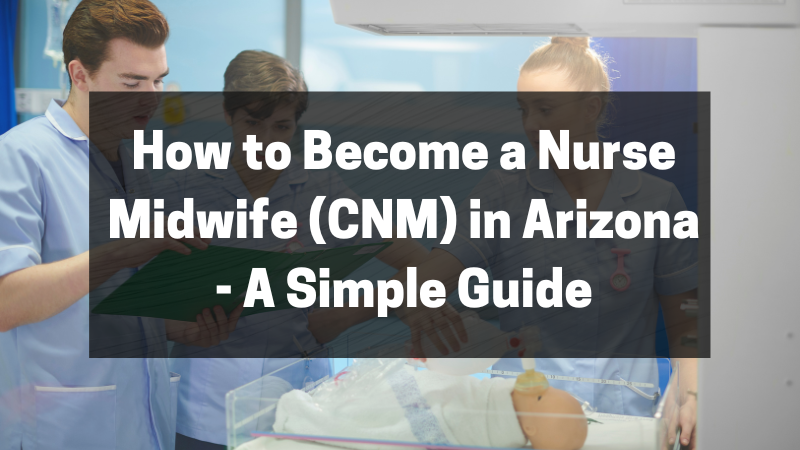The nursing industry is always advancing. And the more we know, the more we need professionals who are trained in specialized fields.
One of the most in-demand specializations is nurse-midwifery.
But how do you become a certified nurse midwife (CNM)?
Since it is an advanced practice of nursing, becoming a CNM involves additional training and certification. And that, in turn, involves paperwork and a checklist of requirements.
But don’t worry! We will make sure you don’t miss out on anything.
We’ll tell you everything you need to know about how to become a nurse midwife (CNM) in Arizona so that you can have a smooth and successful journey.
We’ll also answer some FAQs to clear out confusion or questions you may have.
Join us as we take you through the process, step by step!
What Is a Certified Nurse Midwife (CNM)?
Before we look into how to become a certified nurse-midwife (CNM), let’s first look at what the job of a CNM entails.
A CNM is a type of advanced practice registered nurse (APRN) who specializes in midwifery.
Nurse-midwives provide reproductive care for women, especially during pregnancy, childbirth, and recovery.
They also often specialize in women’s health.
How to Become a Nurse Midwife (CNM) in Arizona in Five Steps
Are you already an RN? If not, you can read our simple guide on how to become an RN in Arizona.
If you are already an RN, you just need to follow five main steps to become a CNM:
- Choose an accredited nursing school
- Graduate from a nurse-midwifery graduate program
- Gain national certification in nurse-midwifery
- Apply for advanced practice registered nurse (APRN) status
- Maintain your credentials
Keep on reading for all of the details!
Step #1: Choose an Accredited Nursing School
All registered nurses (RNs) who want to become APRNs have to undergo higher education – either a Master’s degree or a Doctorate.
However, you need to make sure you enroll in a program that is accredited by the Accreditation Commission for Midwifery Education (ACME).
You can check out the full list of accredited institutions in the United States on their website.
Arizona currently has no ACME-accredited programs, although the University of Arizona at Tucson Campus is undergoing pre-accreditation.
You may choose to enroll in a nearby state that has accredited programs, or you can search for an ACME-accredited online program that partners with local health institutions for your clinical experience.
In general, most accredited programs require the following for admission:
- Registered nurse (RN) license
- Complete nursing prerequisite courses
- At least 1 year of RN work experience
- A minimum GPA
- GRE General Test
- Essay or statement of purpose
- Letters of recommendation
A Bachelor’s degree in Nursing is typically required, but ACME does also allow Associate degrees as long as you can complete the nursing prerequisite courses.
Step #2: Graduate from a Nurse-Midwifery Program
The length of your higher studies will depend on the institution you enroll in, but there are some typical features of nurse-midwifery programs.
There will be classroom education, which usually ranges from forty- to sixty-semester credits. This covers a variety of topics, from ethics to biostatistics.
Then there will be clinical education, which usually takes up about a thousand hours. This is where you practice everything you learned in the classroom.
Most accredited institutions also allow students to take a dual focus in nurse-midwifery and women’s health. So if you want to become a certified women’s health nurse practitioner (WHNP), you can look for programs that allow this.
Step #3: Gain National Certification in Nurse-Midwifery
Once you graduate from an accredited nurse-midwifery program, the Arizona Board of Nursing requires you to get national certification in nurse-midwifery.
You can send your application to the American Midwifery Certification Board (AMCB). And if you want to specialize in women’s health as well, you can apply to the National Certification Corporation.
If your application is approved, you can sign up for your exam. It will be proctored by Applied Measurement Professionals (APM) at their test centers in Glendale, Mesa, or Tucson.
To prepare for the nurse-midwifery exam, you can review the official AMCB Candidate Handbook.
The exam will be done on a computer, and it will consist of 175 multiple-choice questions.
In four hours, you will have to answer questions on:
- Antepartum (worth 19-26%)
- Intrapartum (worth 17-26%)
- Postpartum (worth 15-18%)
- Gynecology (worth 15-18%)
- Women’s health and primary care (worth 8-16%)
- Newborn (worth 7-16%)
And if you’re trying to become a certified WHNP, you can study the WHNP Candidate Guide to prepare for the 150 questions – as well as up to twenty-five unscored pretest questions.
In three hours, you will have to answer questions on:
- Gynecology (worth 35-40%)
- Obstetrics (worth 25-30%)
- Primary care (worth 10-15%)
- Pharmacology (worth 5-10%)
- Diagnostic testing and physical assessment (worth 10-15%)
Step #4: Apply for Advanced Practice Registered Nurse (APRN) Status
After national certifications, you will need to apply for advanced practice registered nurse (APRN) status.
To do this, you’ll need to apply to the Arizona Board of Nursing (AZBN).
These are the things you will need to submit:
- A current Arizona RN license OR current RN license with multistate privileges in another compact state.
- An official transcript sent directly from your CNM school
- An official letter sent directly from the program to AZBN, stating the role and population focus of the program.
- Proof of National Certification or recertification as a CNM from the AMCB.
- Verification that you have met practice requirements by:
- Completing your CNM program within the past five years; or
- Practicing for a minimum of 960 hours within the past five years.
- Criminal background check
- Documentation regarding citizenship/nationality/alien status.For a list of acceptable documents see Citizenship and Alien Status.
Nurse-midwives may also apply for prescribing and dispensing privileges. To do so, they must have:
- completed a 3 semester-hour pharmacology course within the last 3 years OR
- shall submit written evidence of 45 contact hours of education in pharmacology or clinical management of drug therapy within the last 3 years.
You must also apply for a DEA number if you are going to prescribe or dispense controlled substances.
If your application lacks any information or documentation, you will receive a notice from the board. You can easily check your application status in AZBN’s online verification system.
Step #5: Maintain Your Credentials
An active APRN status is only the beginning of your journey!
You’ll need to maintain your RN license and submit proof of a current CNM certification.
To maintain CNM certification, you will need to use AMCB’s Certificate Maintenance Program.
This gives you two options over a five-year cycle:
- Retake the CNM certification exam
- Complete three certificate maintenance modules and twenty hours of continuing education
If you have an active DEA number, then you will need at least 3 CE hours related to opioids, substance use disorder, or addiction when you renew your CNM license.
Frequently Asked Questions About Becoming a CNM in Arizona
Which Arizona Schools Are Accredited by the Accreditation Commission for Midwifery Education (ACME)?
As of this writing, there is only one Arizona school that is pre-accredited by ACME, and that is the University of Arizona at Tucson.
How Much Do CNMs in Arizona Make?
According to the Bureau of Labor Statistics, CNMs in Arizona earn a mean annual salary of $108,190.
Your exact salary will depend, however, on several factors, such as what city you are in, how many years of experience you have, what facility you work in, etc.
What Are the Highest-Paying States for CNMs?
According to the Bureau of Labor Statistics, the highest-paying states for CNMs are California, West Virginia, Hawaii, Massachusetts, and Oregon.
You can find this table on the BLS website.
Do You Have to Study a CNM Graduate Degree In-Person?
No! Since there aren’t many accredited nurse-midwife programs, there are three main ways you can study for a CNM graduate degree: in-person, online, or hybrid.
Just make sure you enroll in an ACME-accredited program.
Can I Get a Temporary License?
Yes! If you’re an RN who needs to practice while waiting for your certification exam, you can apply for a temporary license on your APRN application.
This license is valid for six months, and it becomes invalid if you fail your exam.
You can learn more about how to get a temporary permit here.
Conclusion
And that’s all you need to do to become a CNM in Arizona!
Obviously, it will take a while to accomplish everything – mostly because of the further education required.
However, the wait will be worth it. You will have a meaningful and rewarding career afterward.
Just follow all of our steps in this guide, and you’ll become a CNM before you know it.
We wish you all the best!

